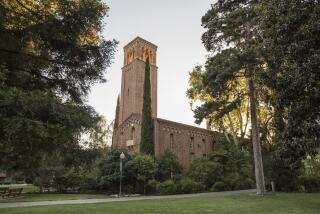Rural School’s Recruiting Earns an A : Education: Faced by declining enrollment as economy sputtered, school advertised its quiet learning atmosphere for troubled students. Now it’s seeking families as well.
- Share via
CLAYTON, N.M. — From the moment he arrived at Clayton High School, David Dailey says he knew he was a little different.
Maybe it was his T-shirts and sneakers in classrooms where many students wear Western shirts and cowboy boots. Maybe it was his mountain bike alongside muddy pickup trucks outside.
Maybe it was his ponytail.
Whatever the differences, the 17-year-old senior says he might not have finished high school if he hadn’t moved to Clayton. He was one of four boys who accepted an offer to live in this town of 2,500 residents in New Mexico’s remote northeastern corner.
Two years ago, Clayton school officials faced state funding cutbacks because of sharply declining enrollment. Families were leaving, unable to stay afloat as the regional economy sputtered.
Superintendent Claude Austin had an idea to counter the declining enrollment: advertise Clayton High School as a refuge for urban students seeking an intimate learning atmosphere in an environment devoid of many of the problems that plague cities.
There were four takers, including three boys who arrived as so-called discipline problems and stayed about one semester each before returning home promising to behave.
Dailey--who came from Farmington, N.M.--was the fourth student to accept the offer but the only one to return for his senior year. His parents pay $400 monthly to a sponsor family for room and board.
“I was going down the wrong track,” Dailey says. “I wanted to stop it before I wound up in jail. . . . If I had stayed in Farmington, I think I would have hurt somebody or myself.”
Beyond the four high school students, school officials say there has been an unexpected offshoot from the recruiting pitch. They say enrollment is up at the elementary and junior high schools because several families have moved to Clayton, including some ex-residents.
“There were a lot of former students who graduated, moved away, got married and had kids,” says John Burgess, principal at Clayton High School. “They saw what we were doing to attract students and looked at their own situation. Then I guess they said, “ ‘Let’s go back to Clayton.’ ”
Although not advertising anymore, Austin and Burgess agreed the recruiting program will continue as long as there is interest.
Clayton is 10 miles from the Oklahoma and Texas panhandles. The high school has 222 students this fall, with 812 students in all grades.
In the early 1990s, the agriculture industry slowed, and as ranchers consolidated operations, the area’s population fell. The high school--enrollment 276 in 1986--was losing about 10 to 15 students each year.
Austin made his pitch through newspaper advertisements in Albuquerque, N.M., and Amarillo, Tex. News organizations flocked to Clayton to report the unusual offer.
“We actually believe our schools are as good or better than any of the private schools in the state,” Austin says.
Austin and Burgess agree Clayton isn’t completely devoid of problems, even where drugs are involved. But they tout the school board policy allowing corporal punishment for many rules violations. Another advantage for administrators is Clayton’s size.
“If students are doing something they’re not supposed to be doing, it gets back to me,” Burgess says. “There are rules and regulations everywhere. The difference is that here they’re enforced on a regular basis.”
More to Read
Sign up for Essential California
The most important California stories and recommendations in your inbox every morning.
You may occasionally receive promotional content from the Los Angeles Times.













